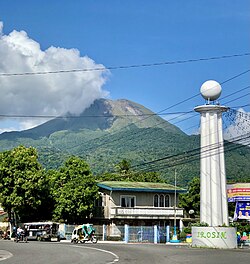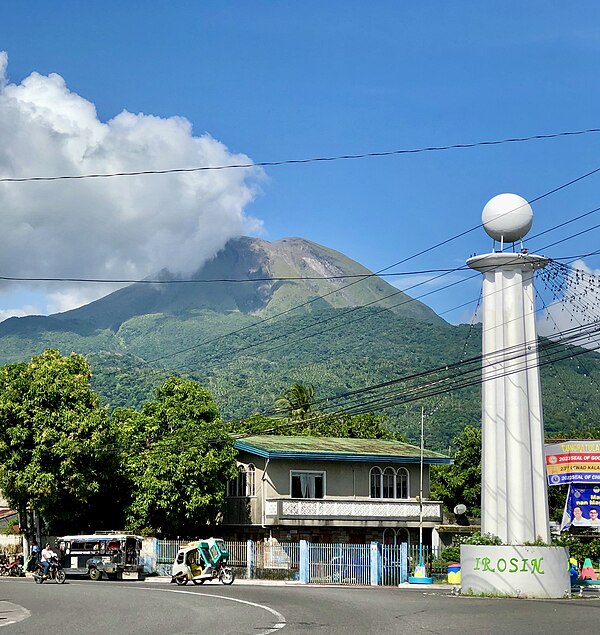Irosin
Municipality in Sorsogon, Philippines From Wikipedia, the free encyclopedia
Irosin, officially the Municipality of Irosin (Southern Sorsoganon: Bungto san Irosin; Waray: Bungto han Irosin, Tagalog: Bayan ng Irosin), is a municipality in the province of Sorsogon, Philippines.
Irosin | |
|---|---|
| Municipality of Irosin | |
 Irosin Beacon with Mount Bulusan in the background | |
 Map of Sorsogon with Irosin highlighted | |
Location within the Philippines | |
| Coordinates: 12°42′18″N 124°01′55″E | |
| Country | Philippines |
| Region | Bicol Region |
| Province | Sorsogon |
| District | 2nd district |
| Barangays | 28 (see Barangays) |
| Government | |
| • Type | Sangguniang Bayan |
| • Mayor | Alfredo J. Cielo Jr. |
| • Vice Mayor | Christian D. Lim |
| • Representative | Manuel L. Fortes Jr. |
| • Municipal Council | Members |
| • Electorate | 39,689 voters (2022) |
| Area | |
• Total | 149.87 km2 (57.87 sq mi) |
| Elevation | 168 m (551 ft) |
| Highest elevation | 791 m (2,595 ft) |
| Lowest elevation | 20 m (70 ft) |
| Population (2020 census)[3] | |
• Total | 59,267 |
| • Density | 400/km2 (1,000/sq mi) |
| • Households | 12,753 |
| Economy | |
| • Income class | 2nd municipal income class |
| • Poverty incidence | 26.41 |
| • Revenue | ₱ 312.5 million (2022) |
| • Assets | ₱ 609.6 million (2022) |
| • Expenditure | ₱ 275.9 million (2022) |
| • Liabilities | ₱ 272 million (2022) |
| Service provider | |
| • Electricity | Sorsogon 1 Electric Cooperative (SORECO 1) |
| Time zone | UTC+8 (PST) |
| ZIP code | 4707 |
| PSGC | |
| IDD : area code | +63 (0)56 |
| Native languages | Sorsogon language Tagalog |
| Website | www |
History
Summarize
Perspective
This section needs additional citations for verification. (November 2022) |
Dating back to 1847, Irosin was an inland valley devoid of humans and covered by a vast forest with thriving biodiversity, making it one of the last places in the Philippines to be occupied by settlers. In the early 1800s, most natives lived along the coastal areas, allowing them greater access to commercial, travel, and communication opportunities.
Until settlers from Bulusan came in search of wild quarry and rattan, Irosin remained an undisturbed wildlife sanctuary. These pioneers cleared a settlement beside a river using the slash-and-burn method, resulting in a clearing called Hin-ay. This Albayanon word denotes the arrangement of abaca yarn or tupos[spelling?] into a zigzagging pattern (hinan-ay) as preparation for weaving. The hin-ay pattern was drawn to represent the weaving rivers crisscrossing from the mountains down the valley. Another account suggests that the word hin-ay came from the term an-hay, meaning gradually ascending. The original settlement, now called San Agustin, is east of the town proper at a higher elevation, hence the gradual ascent from the lower villages to the former barrio center of San Agustin.
In 1847, Hin-ay was declared a barrio of Bulusan. The Gobernadorcillo of Bulusan visited Hin-ay and appointed Apolonio Capido as the first barrio lieutenant. Deeply influenced by Catholicism brought by Spanish friars, the natives of Hin-ay built a makeshift chapel dedicated to Saint Michael the Archange. Over the years, the original clearing grew into a bustling community, and the settlers requested that church authorities grant San Miguel a status independent from Bulusan. The petition was approved, and Holy Masses were regularly held on Sundays and holidays. In 1876, the parish of San Miguel was officially recognized with Father Mariano Miranda as its parish priest, and Hin-ay became known as San Miguel. On December 12, 1879, through a Royal Decree executed by Governor-General Domingo Moriones y Murillo, San Miguel was made a duly constituted pueblo or town.
During that time, Pedro Fruto (1881-1882), Domingo Gamba (1883-1884), and Juan Gallarda (1885-1886) served as public officials with the title Capitanes del Pueblo. From 1880, the town of San Miguel flourished as an independent political unit under the Province of Albay, as Sorsogon was not separated from its mother province until October 10, 1894. The first Guardia Civil arrived in Irosin in 1883, consisting of Filipinos headed by a Spanish Captain. With the spread of the underground movement called hombres rebeldes by the Spaniards in 1894, more Spanish forces called casadores were dispatched to Irosin and imposed curfew hours to curtail local uprisings.
In 1887, during the incumbency of Father Esteban Rivera, the name San Miguel was changed to Irosin. The word came from the local term iros, meaning "to cut off a part," traced to an old tailor's term synonymous with tabas, as in ”irosi an hiniro” or "cut a part of the cloth." Iros likely represented the image of floodwaters eroding riverbanks and cutting through lands to form another river route.
Irosin frequently experienced erosion due to river inundations. On December 24, 1933, massive flooding caused numerous fatalities. To prevent the violent surge of the river from eroding the town's mainland, a concrete river control dike was constructed in 1937 under Mayor Felipe Santiago and Congressman Norberto Roque.[5][better source needed]
Contemporary period
On April 10, 1989, Irosin was defended by military and police forces, led by Lieutenant Antonio Dy, against approximately 200 communist rebels of the New People's Army, which resulted in 20 rebel casualties; and the deaths of three female civilians in the crossfire.[6] Dy later received the "Medalya ng Kagitingan" Award in August for leading his 13 policemen to defend Irosin's municipal hall.[7]
The local tourism industry has significant potential, as ecological tourism is a global trend and the national government aims to develop Bicol as a major tourist hub. Given its variety of natural tourist spots and strategic location, Irosin serves as a convergence area for both foreign and domestic tourists and visitors.[8]
Geography
Summarize
Perspective
This section needs additional citations for verification. (November 2022) |
Environment
Irosin features natural parks, hot and cold springs, and historical landmarks. The Mapaso mineral hot spring is known for its purported healing properties. Irosin is also a starting point for mountaineering and ecological treks, providing entry and exit to Bulusan Volcano Natural Park (BVNP), one of the remaining tropical forests and a protected area in the Bicol Region. Mount Jormajam and Mount Mara-ot Banwa are also used for mountaineering and trekking.
Climate
| Climate data for Irosin, Sorsogon | |||||||||||||
|---|---|---|---|---|---|---|---|---|---|---|---|---|---|
| Month | Jan | Feb | Mar | Apr | May | Jun | Jul | Aug | Sep | Oct | Nov | Dec | Year |
| Mean daily maximum °C (°F) | 27 (81) |
28 (82) |
29 (84) |
31 (88) |
31 (88) |
30 (86) |
29 (84) |
29 (84) |
29 (84) |
29 (84) |
29 (84) |
28 (82) |
29 (84) |
| Mean daily minimum °C (°F) | 22 (72) |
21 (70) |
22 (72) |
23 (73) |
24 (75) |
25 (77) |
25 (77) |
25 (77) |
25 (77) |
24 (75) |
23 (73) |
23 (73) |
24 (74) |
| Average precipitation mm (inches) | 65 (2.6) |
44 (1.7) |
42 (1.7) |
39 (1.5) |
87 (3.4) |
150 (5.9) |
184 (7.2) |
153 (6.0) |
163 (6.4) |
154 (6.1) |
127 (5.0) |
100 (3.9) |
1,308 (51.4) |
| Average rainy days | 13.9 | 9.2 | 11.0 | 12.5 | 19.6 | 24.3 | 26.5 | 25.0 | 25.5 | 24.4 | 19.4 | 15.1 | 226.4 |
| Source: Meteoblue (modeled/calculated data, not measured locally)[9] | |||||||||||||
Political geography
Irosin is the only landlocked municipality in Sorsogon province.
Irosin is politically subdivided into 28 barangays, each consisting of puroks, and some with sitios.
- Bagsangan
- Bacolod (Poblacion)
- Batang
- Bolos
- Buenavista
- Bulawan
- Carriedo
- Casini
- Cawayan
- Cogon
- Gabao
- Gulang-Gulang
- Gumapia
- Santo Domingo (Lamboon)
- Liang
- Macawayan
- Mapaso
- Monbon
- Patag
- Salvacion
- San Agustin (Poblacion)
- San Isidro (Palogtok)
- San Juan (Poblacion)
- San Julian (Poblacion)
- San Pedro (Poblacion)
- Tabon-Tabon
- Tinampo
- Tongdol
Demographics
| Year | Pop. | ±% p.a. |
|---|---|---|
| 1903 | 8,644 | — |
| 1918 | 14,775 | +3.64% |
| 1939 | 17,017 | +0.68% |
| 1948 | 19,317 | +1.42% |
| 1960 | 23,134 | +1.51% |
| 1970 | 27,953 | +1.91% |
| 1975 | 30,989 | +2.09% |
| 1980 | 34,978 | +2.45% |
| 1990 | 37,887 | +0.80% |
| 1995 | 41,005 | +1.49% |
| 2000 | 45,507 | +2.26% |
| 2007 | 49,968 | +1.30% |
| 2010 | 51,777 | +1.30% |
| 2015 | 56,662 | +1.73% |
| 2020 | 59,267 | +0.89% |
| Source: Philippine Statistics Authority[10][11][12][13] | ||
Economy
Poverty incidence of Irosin
10
20
30
40
50
2000
48.63 2003
44.69 2006
33.40 2009
34.18 2012
28.45 2015
37.34 2018
32.64 2021
26.41 Source: Philippine Statistics Authority[14][15][16][17][18][19][20][21] |
Culture
The most common cultural activities are the annual Santacruzan, barangay fiestas, and town fiestas, which showcase the Paray Festival. The Paray Festival, held in September, culminates with the street play Viva San Miguel in honor of Saint Michael Archangel, the patron saint of Irosin.
Education
Primary education
Known primary schools in the town include Irosin Central School and Holy Spirit Academy of Irosin. Additionally, each barangay has a government-run elementary school.
- Secondary education
Irosin offers numerous secondary educational institutions. The largest public high school is Gallanosa National High School, with secondary schools also located in some of Irosin's larger barangays, such as Gabao National High School and Irosin North National High School. Holy Spirit Academy of Irosin is the only private secondary school.
- Tertiary education
Irosin is home to Veritas College of Irosin and the Irosin Institute of Science and Technology, the latter accredited by the Technical Education and Skills Development Authority (TESDA). [22]
References
External links
Wikiwand - on
Seamless Wikipedia browsing. On steroids.



